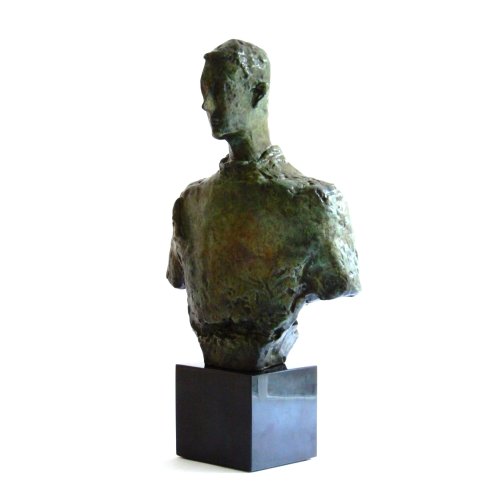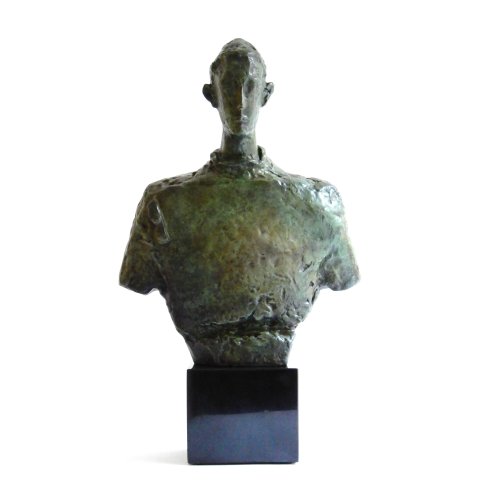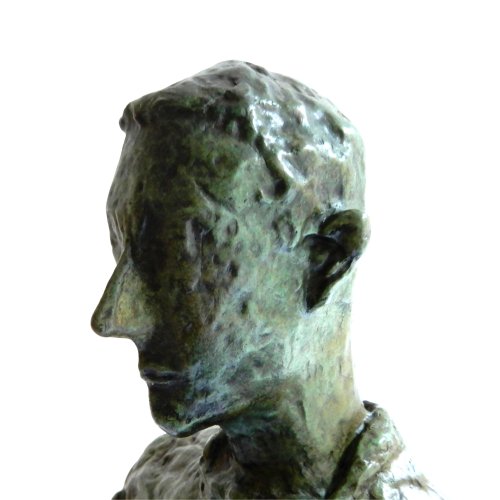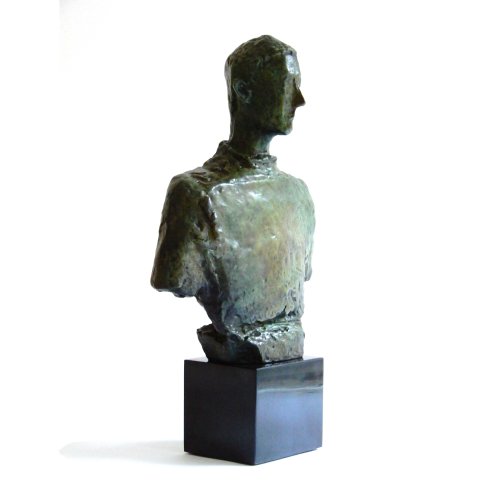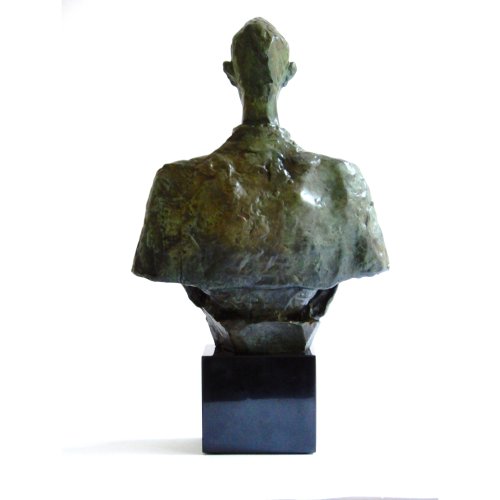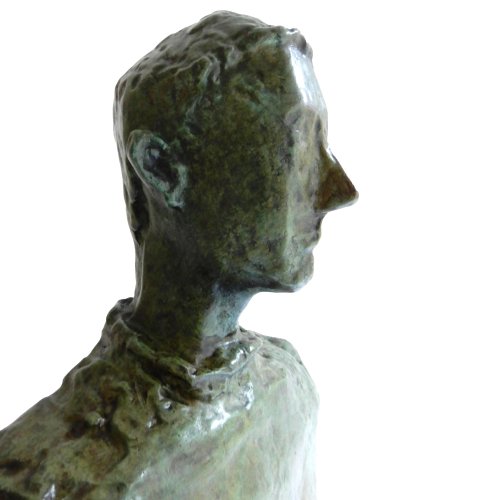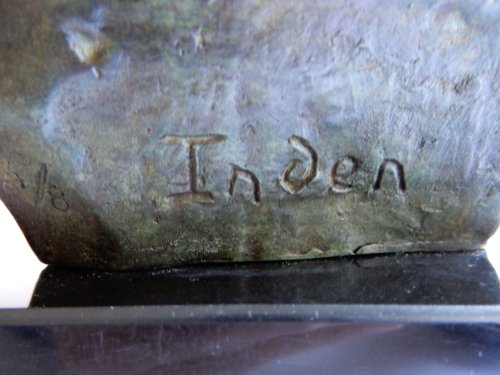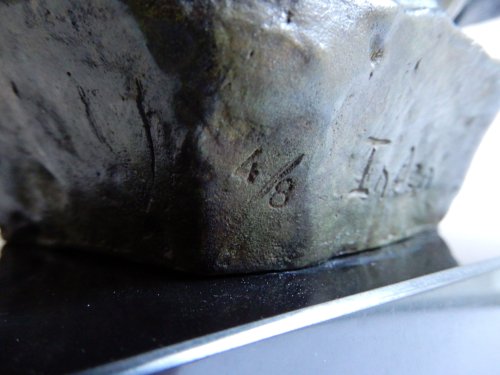Léon Indenbaum (1890-1981) Bust of Rembrandt Bugatti
About this piece
This beautiful bust was created by Léon Indenbaum in 1915, depicting his friend Rembrandt Bugatti (1884-1916). It was quite common at La Ruche to portray friends, and besides his beloved wife Céline and Rembrandt Bugatti, Léon Indenbaum also portrayed several other friends, including Chaïm Soutine, Tsuguharu-Léonard Foujita, Chana Orloff, and Jeanne Hébuterne, the wife of Modigliani.
What I find interesting about this bust is that Indenbaum captured Rembrandt Bugatti very well, highlighting his characteristic nose, widely protruding small ears, and somewhat pointed face. He wears a short jacket closed on the side with a large button, likely designed by Bugatti himself, as he designed much of his own clothing.
This portrait was made just a few months before Bugatti's untimely death in January 1916. Rembrandt, the son of the famous furniture designer Carlo Bugatti and the younger brother of Ettore Bugatti, the founder of the Bugatti automotive brand, grew up in Milan and moved to Paris in 1902.
With great talent, Bugatti had been sculpting for a long time, especially drawn to creating animal sculptures. He spent a lot of time with animals at the Jardin des Plantes in Paris. He was a somewhat withdrawn, sensitive person who loved nature and animals.
His sculptures were already being cast at the renowned Hébrard foundry in Paris when he was just 17, and his animal sculptures were highly regarded even then. Today, Rembrandt Bugatti's sculptures are highly sought after and valuable, with prices ranging from €60,000 to over a million euros for a single sculpture.
In 1907, he moved to Antwerp, where he lived until the outbreak of World War I in 1914. There, he spent a lot of time at the Antwerp Zoo, associating with artists like Alberic Collin and Isidore Opsomer.
In 1914, he returned to his studio in Montparnasse but also worked part-time as a volunteer at the Red Cross Military Hospital in Antwerp, where he witnessed much suffering. When his beloved animals in the zoo were shot to prevent them from starving, it likely became too much for him. In January 1916, he took his own life at the age of just 31.
The bronze bust is cast cire perdue and has a darkgreen and brown patina and is placed on a black marble base. The bust is signed on the back with "Inden," 4/8, and the hallmark of Founderie ILHAT.
This postume bronze is an exclusive edition made by the family of Léon Indenbaum. This sculpture also comes with an official certificate signed by Léon Indenbaum's grandson. The bust is a first official edition, cast from the original plaster made in 1915 by Léon Indenbaum, commissioned by the family. This is only the fourth copy, and a maximum of 12 copies will be cast. The bronze is registered with ADAGP (Society of Authors in the Graphic and Plastic Arts) in Paris.
Biography:
Léon
Indenbaum (Tcherikov, now Belarus, 1890 - Opio, 1981) was a
Russian-French sculptor associated with the École de Paris artists. His
art was innovative, drawing inspiration from the classics, African art,
Cubism, and Expressionism.
Indenbaum grew up in the shtetl of Tcherikov with his grandfather, a bookbinder of art books. After elementary school, he trained as a woodworker. Recognizing his talent, the school director arranged for him to attend the Academy of Decorative Arts in Vilnius.
After completing his education there, Indenbaum sought further training and was admitted to the Imperial Academy in Odessa. He studied there for several years until he mistakenly signed up for five years of military service in the Imperial army. With the help of an engineer from Vilnius, he escaped to Paris in March 1911, where he had contacts with an artist friend.
In Paris, he found himself at 'La Ruche' in Montparnasse, an artists' village housed in a round building originally a wine pavilion at the 1900 World Exposition. It was rebuilt by the successful artist Alfred Boucher, who aimed to support poor artists. La Ruche provided studio apartments, each shaped like a slice of cake, with a small kitchen and loft space.
Indenbaum had a studio on the 2nd floor next to Chagall, who, like him, had recently arrived from Russia. Indenbaum lived in La Ruche until 1927, and for a period, he also had a second studio in Montparnasse.
About 200 artists lived in La Ruche, many from Eastern Europe and many were Jewish. Some, like Chaïm Soutine, Ossip Zadkine, Jacques Lipschitz, Chana Orloff, Michael Kikoïne, Moïse Kisling, and Amadeo Modigliani, achieved world fame.
From 1911 to 1919, Indenbaum studied sculpture at the Académie La Grande Chaumière under Antoine Bourdelle, initially as a student and later as his assistant.
In 1912, Indenbaum exhibited at the Paris Salon d'Artistes Indépendants. Despite his poverty, Jacques Doucet, a great art collector and couturier, saw a bust by Indenbaum and commissioned him to create a similar one in onyx. Doucet was pleased and offered Indenbaum a monthly stipend of 1000 francs. In 1914, Indenbaum created the impressive relief 'Musiciens et antilopes' in pink onyx, which sold for 3.3 million euros at Christie's in 2004.
René Poiret, bankers George and Marcel Bénard, and decorator Marcel Coard were regular buyers of Indenbaum's work.
Léon married his muse, Céline Hénin, and they had a daughter, Dinah, in late 1914. His circle of friends included artists like Chaim Soutine, Amadeo Modigliani, Tsuguharu Foujita, Chana Orloff, Michael Kikoïne, and Diego Rivera. Modigliani and Rivera both portrayed Indenbaum in 1913 and 1916. Indenbaum also created portraits of his friends, enjoying the happiest period of his life.
The 1929 stock market crash made life difficult. Many lost their fortunes, and the political climate in France grew hostile toward immigrant artists. The term 'École de Paris' was coined to include these artists but later used derogatorily. Many artists faced anti-Semitism and were banned from exhibiting. Indenbaum, forced to flee Paris during WWII, hid in Seine-et-Marne. He survived, though over 60% of La Ruche's Jewish artists perished in the Holocaust.
After the war, Indenbaum returned to Paris to find his studio looted. He lived reclusively, having separated from Céline and with his daughter in the south of France. Many of his friends had died or, in his view, become too commercial. Refusing to affiliate with galleries, Indenbaum worked in isolation, rejecting even significant commissions.
He co-founded the "Groupe des neuf" in 1963, aiming to honour French post-war figurative sculpture. This group included Jean Carton, Paul Cornet, Raymond Corbin, Marcel Damboise, Léopold Kretz, Raymond Martin, Gunnar Nilsson, Jean Osouf, and Léon Indenbaum. Their exhibitions, including one in 2015/2016 featuring Indenbaum's work, underscored their significance.
In 1968, Indenbaum received the prestigious Prix de sculpture Georges Wildenstein. He spent his later years with his daughter in Opio, passing away at 91, dedicated entirely to his art.
Indenbaum's work is displayed in various museums worldwide and occasionally auctioned at major houses like Christie's, Sotheby's, and MacDougall in London.
Literature and sources:
- Family of Indenbaum
- Jeanine Warnod; "Les artistes de
Montparnasse, la Ruche", Éditions Mayer-Van Wilder, Paris 1988. P.42-47,
8, 87,96, 104, 159, 162, 170, 192.
- Nieszawer & Princ;
"Histoires des artistes Juifs de l'École de Paris, 1905-1939", Édition
Les Étoiles, 2020. P. 190-192, 515 and 516.
- Jeanine Warnod; "l'École de Paris", Édition Musée du Montparnasse, 2012. P. 239, 240 and 243.
-
"Chagall, Modigliani, Soutine.... Paris pour école, 1905-1940",
Éditions Musée d'Art et d'Histoire du Judaïsme (MAHJ), Paris, 2020 et
Réunion des Musée nationaux, Grand Palais, 2020. P. 8, 11, 49, 66, 68,
69, 228, 230, 252.
- G. Annenkoff; "Art Russe Moderne", Éditions Laville, Paris, 1928. P. 50 and 51.
Condition
Excellent
Material:
Bronze
Measurements:
Height: 38 cm
(14,96")
Marble base:
Height: 11 cm
(4,33")
Period:
1915, original plaster
Origin:
France
Artist / atelier:
Léon Indenbaum,
